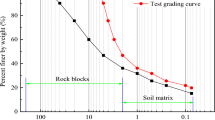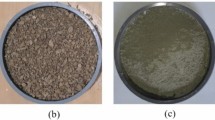Abstract
The term soil improvement is commonly referred to the modification of soil structure in order to obtain a material with better physical and mechanical properties such as strength, stiffness or permeability. With this purpose, one of the most commonly used applications, particularly in coarse-grained soils, is the low pressure injection of cementitious mixtures. In recent years, there has been a growing demand for solutions with limited environmental impact and limited CO2 emissions and, in this regard, the cement present in the injected grout is evidently the weak point of traditional solutions. In this work, the experimental study of geopolymer materials as a substitute of cement mixture for low-pressure injection for coarse-grained soils improvement is presented. The study started with a focus on the geopolymer fresh mixture properties (density, viscosity, …) and the evolution over the time of the mechanical properties (compression and tensile strength and stiffness) comparing three different mix designs at three different monitoring temperatures. The same evaluations were repeated on sand samples injected with the different types of mixtures previously analyzed. For a selected mix design, a permeation test was carried out under controlled conditions to test the pumpability and effectiveness of geopolymer injection. Finally, to deepen the chemical interaction between the injected mixture and interstitial water, an injection test was carried out using a scaled model of a real injection system. The experimental study carried out was aimed both at the analysis of the characteristics of the geopolymer material and at its physical interaction with coarse-grained soil, passing through the measurement of the mechanical characteristics of the geopolymer material and of the solid sand skeleton mixed with geopolymers. Finally, the possible chemical interaction of the mixtures with groundwater was also evaluated in order to highlight any environmental issues. The results shown provide a preliminary but sufficiently broad picture of the behavior of geopolymer mixtures for low-pressure injection for coarse-grained soil improvement purposes both from physical–mechanical and chemical points of view.











Similar content being viewed by others
References
Abdul Aleem MI, Arumairaj PD (2011) A review of seismic assessment of reinforced concrete structure using pushover analysis. Int J Eng Sci Emerg Technol 1(2):118–122. https://doi.org/10.7323/ijeset/v1
Anagnostopoulos CA (2005) Laboratory study of an injected granular soil with polymer grouts. Tunn Undergr Space Technol 20(6):525–533. https://doi.org/10.1016/j.tust.2005.04.005
“AS 1012.10, Methods of Testing Concrete - Determination of Indirect Tensile Strength of Concrete Cylinders Brasil or Splitting Test).” 2000. Australian Standard,Sydney, R2014, NSW, Australia
AS 1012.9, Methods of Testing Concrete; Method 9: Determination of the Compressive Strength of Concrete Specimens.” 1999. Australian Standard, Sydney,NSW, Australia
Donovan NC, Becker AM, Lau GY (1984) Liquefaction mitigation by site improvement- a case study. California, San Francisco
Duarte CM, Losada IJ, Hendriks IE, Mazarrasa I, Marbà N (2013) The role of coastal plant communities for climate change mitigation and adaptation. Nat Clim Chang 3(11):961–968. https://doi.org/10.1038/nclimate1970
Farhan KZ, Johari MAM, Demirboğa R (2020) Assessment of important parameters involved in the synthesis of geopolymer composites: a review. Constr Build Mater. https://doi.org/10.1016/j.conbuildmat.2020.120276
Feely RA, Sabine CL, Lee K, Berelson W, Kleypas J, Fabry VJ, Millero FJ (2004) Impact of anthropogenic CO<inf>2</Inf> on the CaCO<inf>3</Inf> system in the oceans. Science 305(5682):362–366. https://doi.org/10.1126/science.1097329
Flora A, Lirer S, Amorosi A, and Elia G (2006) Experimental observations and theoretical interpretation of the mechanical behaviour of a grouted pyroclastic silty sand. In: proceedings of the 6th European conference on numerical methods in geotechnical engineering - numerical methods in geotechnical engineering, pp. 857–63.
Flora, A, and S Lirer. n.d. Osservazioni Su Alcune Delle Tecniche Di Consolidamento Dei Terreni Più Diffuse in Italia
Guida G, Sebastiani D, Casini F, Miliziano S (2019) Grain morphology and strength dilatancy of sands. Geotech Lett 9(4):245–253. https://doi.org/10.1680/jgele.18.00199
Hendriks CA, Worrell E, De Jager D, Blok K, and Riemer P (2003) Emission reduction of greenhouse gases from the cement industry. Greenhouse Gas Control Technologies Conference, pp. 1–11
Humphreys K, and Mahasenan M (2002) Towards a sustainable cement industry. Substudy 8: climate change
Jiang C, Wang A, Bao X, Ni T, Ling J (2020) A review on geopolymer in potential coating application: materials, preparation and basic properties. J Build Eng. https://doi.org/10.1016/j.jobe.2020.101734
Karol RH (1968) Chemical grouting technology. ASCE J Soil Mech Found Div 94:175–204
Lirer S, Flora A, Evangelista A, Verdolotti L, Lavorgna M, Iannace S (2006) Permeation grouting of a fine-grained pyroclastic soil. Ground Improv 10(4):135–145. https://doi.org/10.1680/grim.2006.10.4.135
Lirer S, Flora A, Borrelli M, and Evangelista A (2004) Modelling low pressure grouting of unsaturated silty sands. In: edited by 5th international conference on ground improvement techniques, pp. 211–218
Medri V (2009) Geopolimeri: ‘ceramiche’ per uno sviluppo sostenibile. Il Sole 24 Ore Business Media, pp. 48–53
Mo B-H, Zhu H, Cui X-M, He Y, Gong S-Y (2014) Effect of curing temperature on geopolymerization of metakaolin-based geopolymers. Appl Clay Sci 99:144–148. https://doi.org/10.1016/j.clay.2014.06.024
Mutman U, Kavak A (2011) Improvement of granular soils by low pressure grouting. Int J Phys Sci 6(17):4311–4322
Nawaz M, Heitor A, Sivakumar M (2020) Geopolymers in construction - recent developments. Constr Build Mater. https://doi.org/10.1016/j.conbuildmat.2020.120472
Proia R, Salvatore E, and Maria CM (2017) Miglioramento Delle Sabbie Con Aggiunta Di Nanomateriali. no. June
Puppala AJ, Pedarla A (2017) Innovative ground improvement techniques for expansive soils. Innov Infrastruct Sol. https://doi.org/10.1007/s41062-017-0079-2
Słowikowski D, and G Kacprzak. 2013. Implementation of low pressure injection for soil reinforcement and sealing – selected application. pp. 111–119.
Spagnoli G, Romero E, Fraccica A, Arroyo M, Gómez R (2021) The effect of curing conditions on the hydromechanical properties of a metakaolin-based soilcrete. Géotechnique 72(5):455–469. https://doi.org/10.1680/jgeot.20.P.259
Taki K, Mukherjee S, Patel AK, Kumar M (2020) Reappraisal review on geopolymer: a new era of aluminosilicate binder for metal immobilization. Environ Nanotechnol Monit Manag. https://doi.org/10.1016/j.enmm.2020.100345
Warner J (2004) Practical handbook of grouting: soil, rock, and structures. Wiley
Funding
The authors declare that no funds, grants, or other support were received during the preparation of this manuscript. The authors have no relevant financial or non-financial interests to disclose.
Author information
Authors and Affiliations
Contributions
All authors contributed to the study conception and design. Material preparation, data collection and analysis were performed by MB and CC. The draft of the manuscript was written by IB and DS, reviewed by ADG, LDP, SM and QN. All authors read and approved the final manuscript.
Corresponding author
Additional information
Publisher's Note
Springer Nature remains neutral with regard to jurisdictional claims in published maps and institutional affiliations.
Rights and permissions
Springer Nature or its licensor (e.g. a society or other partner) holds exclusive rights to this article under a publishing agreement with the author(s) or other rightsholder(s); author self-archiving of the accepted manuscript version of this article is solely governed by the terms of such publishing agreement and applicable law.
About this article
Cite this article
Bocci, M., Cerocchi, C., Sebastiani, D. et al. Geopolymer Materials for Low-Pressure Injections in Coarse Grained Soil: Multiscale Approach to the Study of the Mechanical Behaviour and Environmental Impact. Geotech Geol Eng 41, 445–457 (2023). https://doi.org/10.1007/s10706-022-02260-0
Received:
Accepted:
Published:
Issue Date:
DOI: https://doi.org/10.1007/s10706-022-02260-0




